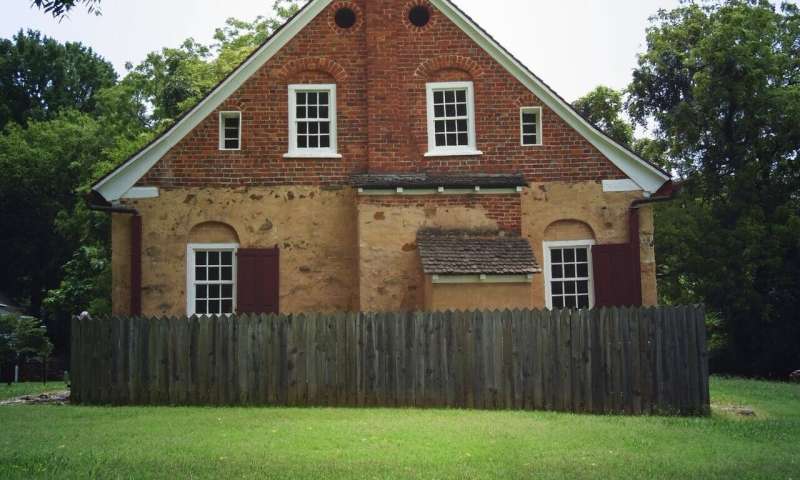Archaeologists unearth a churchyard grave in Jamestown, facing west

It was tradition in 17th century Virginia to bury corpses with the heads pointed west and the feet to the east. This was done so that the eyes would face east, toward Jerusalem and the rapture.
Almost a year ago, archaeologists in Jamestown found a grave—and perhaps the answer to a mystery—while studying the architecture and foundation of a church that was started in 1639.
In this grave, the body was not just wrapped in a shroud, but actually buried in a hexagonal coffin, a symbol of high status. And the head was to the east, looking west. Both of these details hint at a person of some importance.
"We have uncovered other burials facing west instead of east at the 1608 church and in the 1617 church," said Sean Romo, senior staff architect at Historic Jamestowne. "The 1608 one was Reverend Hunt, the first minister out here. In the 1617 burial we believe it is (Gov.) George Yeardley, but we're still working on proving it.
"Both were facing west, and both had status in the community. Yeardley would have been facing his subjects. Another one we found facing the wrong direction was Captain Gabriel Archer—again, a man of position in the community."
In the intricately detailed world of archaeology, which moves at a much slower pace than depicted in the "Indiana Jones" movies, the staff at Historic Jamestowne is still at the stage of speculating as to who this new discovery might be.
They haven't even seen the remains yet.
The gravesite is identified by how layers of soil and clay are disturbed—a sign that they had been dug up in a specific pattern and then shoveled back into place. The shape of the casket is determined by the shape of the grave, and the position of the head and feet is clear because the top of a hexagonal coffin is wider than the bottom.
There is likely little left of the body to submit to modern DNA testing, but head archaeologist David Givens said there is much to learn.
Among the first names that come to his mind at this point is Lord De La Warr, who had been tasked with governing the Virginia Colony from across the sea. He came to the colony in 1610 to help settle conflicts with native tribes, but he returned to England in 1611 for health reasons, leaving his deputy, Samuel Argall, in charge. In 1618, with the colonists tiring of Argall's rule, Lord De La Warr set sail again for Virginia but died three weeks before arrival.
It was long assumed that he was buried at sea, but more recent research led to the conclusion that he was brought to Jamestown for burial.
But where?
The 1639 church, where the grave was discovered, had been built on the same ground where a previous church had been built in 1617. And Givens is intrigued by the fact that the grave is not in the churchyard but directly adjacent to the church itself.
"The acting governor, Samuel Argall, hated Lord De La Warr," Givens said. "If the decision was made to bury him outside the church rather than inside, that may have been something Argall decided."
There will be no definitive answer anytime soon. The discovery of the grave, while interesting, is less important to the archaeologists' mission than other priorities on the site. Eventually geneology experts, such as renowned geneticist Turi King at University of Leicester in England, will have a say in identifying the remains.
"We're just dirt surgeons in a way," Givens said.
While they wait for further answers, they will continue to study what lies beneath the ground where the earliest settlers lived.
"It's the ongoing initiative of the Jamestown Rediscovery program," Romo said. "We honor those from the past who lived and died at the beginning of our nation. We're scientifically trying to figure out many of the different attributes of the early population. Everything we find could potentially be of some value toward that goal."
©2019 Daily Press (Newport News, Va.)
Distributed by Tribune Content Agency, LLC.




















